Kayakers headed to whitewater rapids in this South Carolina town will need some skill
A stretch of the Catawba River in Great Falls, S.C., which had not had water flowing through it in more than a century, now has rapids with turbulence intense enough to challenge top kayaking and canoeing experts.
And that could pose a threat for novices.
The whitewater facility opened on March 19.
One could hear the current’s loud roar that day as water slapped against kayaks. Hundreds of paddlers gathered to traverse a channel of the river called the “long bypass.” Water had not been there since 1906.
After 117 years, Great Falls gets its water back. New whitewater rapids to boost SC town
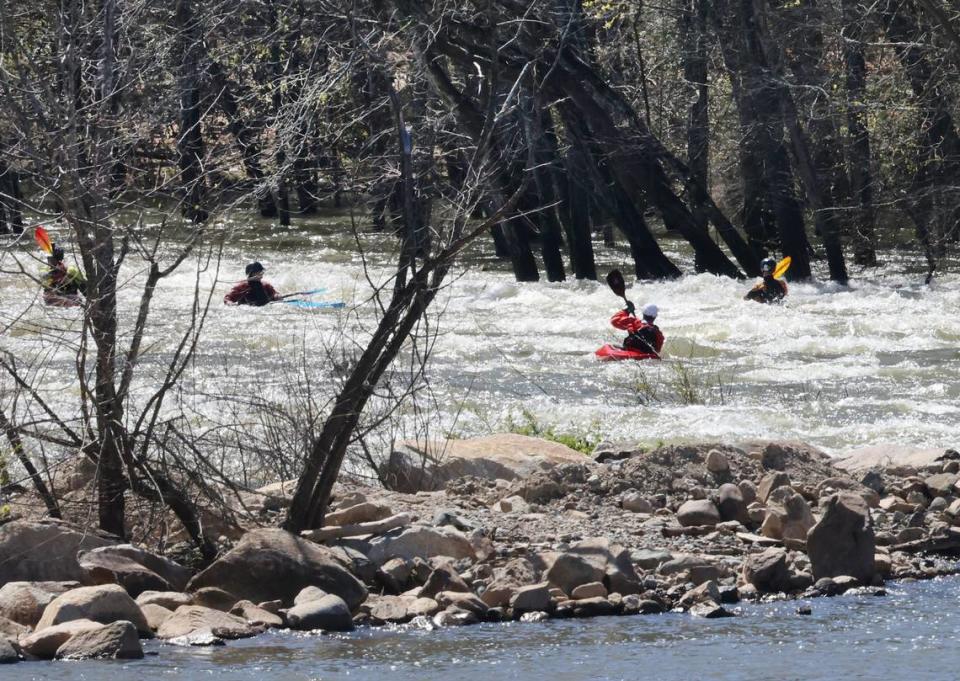
For people coming to this small South Carolina town to enjoy their sport, swift-moving water with forceful currents are to be expected. Some who have experienced the long bypass say it’s safe -- if you have the right gear, an appropriate whitewater craft, and people with you who have experience.
Expert paddler Dennis Huntley, who has been kayaking for more than 50 years, said he believes the river is safe and easy to paddle: “(but) if you want a good experience down there and to have fun, without any danger at all, you need a little bit of experience.”
Another experienced kayaker had a different perspective.
“For your novice people, or beginner-type people, or recreational people, your mainly flat-water type paddling, they’ve got no business being out there,” said Chris Brewer, a certified kayak instructor.
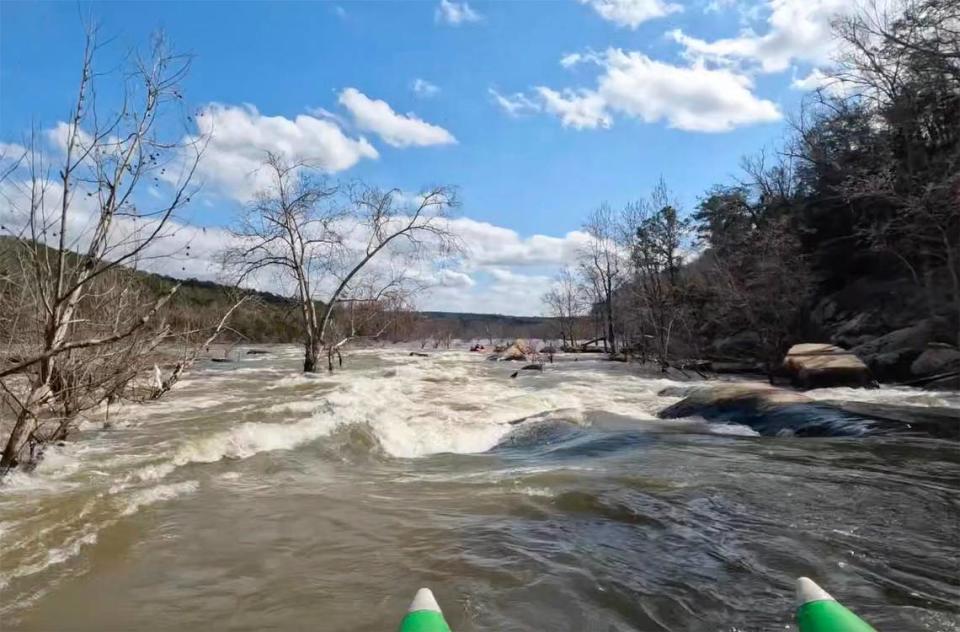
Duke Energy, which owns the site and commonly refers to it as the “Great Falls-Dearborn Project,” has described the channels as leisurely kayaking and canoeing that is appropriate for families and individuals.
When asked earlier this week about safety concerns that have recently been voiced, Duke sent the following statement:
“The intent of this project was to return water to the original (bypassed) river channel and to provide access to this channel on scheduled recreation flow release days/times. As public safety is always a priority for Duke Energy, it was taken into account throughout the planning, design and implementation process. Through intentional signage and educational resources at the Nitrolee Access Area, and signage and markers at the diversion dams, users are empowered to make their own decisions based on their comfort and experience level. The long bypassed (natural) river section, that now has flow returned to it, contain rapids that have been classified by the paddling community as Class II and III. Like any other natural, free-flowing body of water, the long bypassed river section is variable as water flow and other natural causes may impact the experience. This project does not have on-site staff or lifeguards and is use-at-your-own-risk.
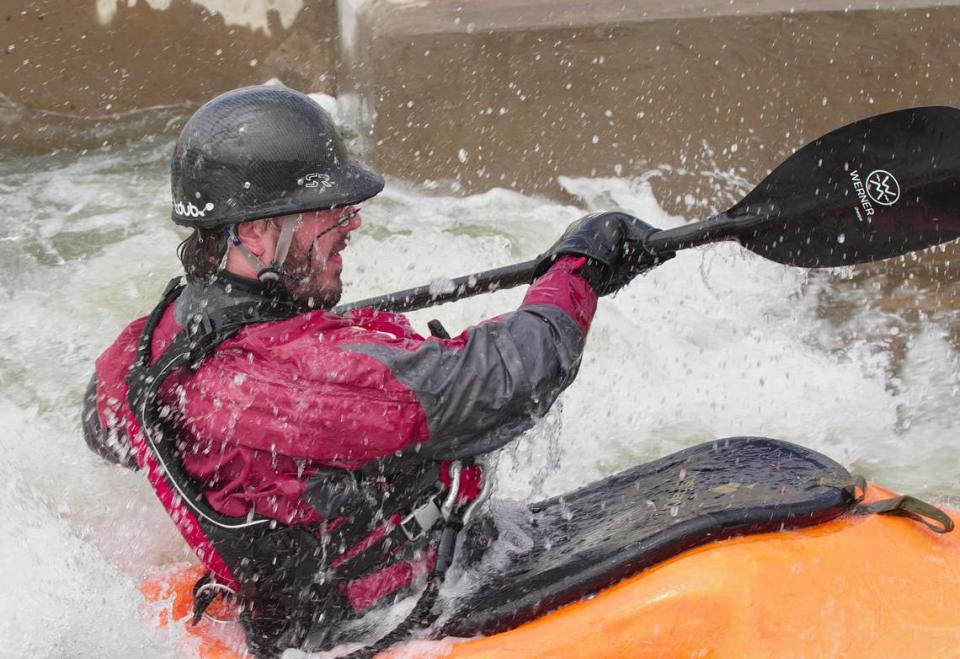
Duke Energy started construction on the Great Falls-Dearborn project in 2020.
As part of a new license for the Catawba-Wateree Project in 2015, the Federal Energy Regulatory Commission requires Duke to provide recreation, enhancement to water quality and quantity, wildlife and land conservation along the river.
What to know about the rapids
There are two channels -- the long bypass and the short bypass.
The long bypass is a 2.25-mile stretch and has Class II and III rapids. The short bypass, which is not yet open, will have faster water -- Class III and IV rapids -- flowing over three-quarters of a mile.
The higher the class number assigned to the rapids, the more intense the water speed will be. Experts say Class II rapids are considered easy to maneuver while Class IV rapids are for advanced paddlers.
Duke Energy controls how much water is released in the channels.
Water enters the long bypass through two man-made flows. The main flow, which has more turbulence, provides water for paddlers downstream and for aquatic habitat enhancement. Duke Energy representatives said paddlers should stay out of the main flow. There are warning signs and red posts discouraging people from entering.
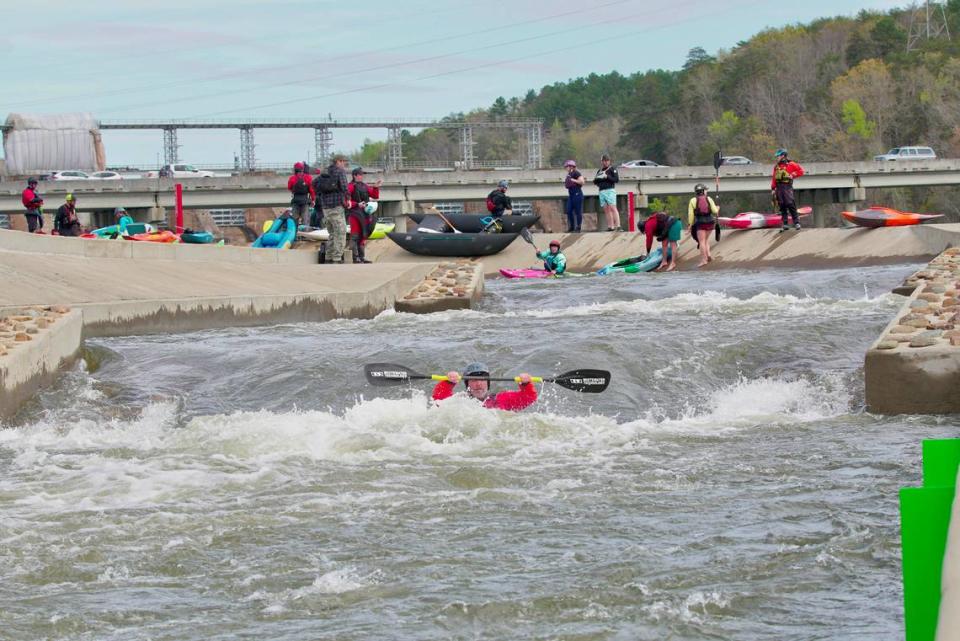
The other flow is the boater bypass, or what Duke has labeled the “paperclip.” It is designed so paddlers can enter the long bypass channel. The paperclip also has a ramp that paddlers can use to re-enter the water, if they want to repeat their experience there. Precise movement is needed to navigate this area.
The main entrance is the Nitrolee Access Area off I-77 exit 55 if you’re traveling south from Charlotte, or exit 48 if you’re traveling north from Columbia.
Signs at the access area direct paddlers to the long bypass, show paddlers how to access the channel, and give details about appropriate watercraft and equipment, said Ben Williamson, a Duke Energy spokesman.
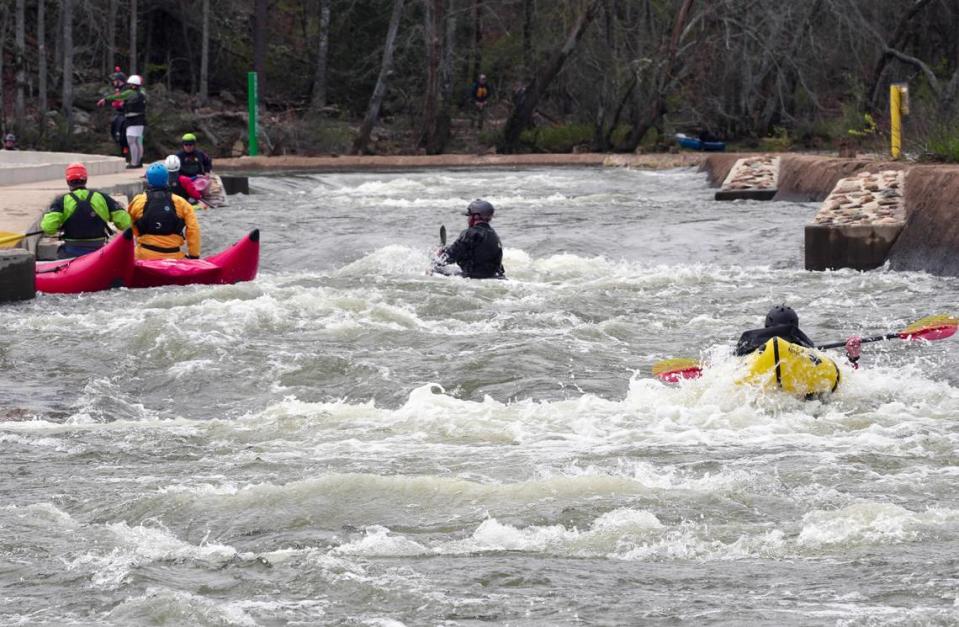
What kayakers are saying
Professional and expert kayakers and canoers who went down the river on March 19, agree that you need experience to navigate the long bypass and the paperclip.
And Brewer said paddlers should not use inner tubes.
“You shouldn’t go out there with tubes or you’re going to have a bad day,” he said.
One aspect of the long bypass that makes it more dangerous than a typical Class III river is the hazards in the water, Brewer said.
Videos shot by professional paddlers in the long bypass show the boaters navigating around boulders, trees and branches that have grown up in the river bed.
In at least one area, the water flows into a forest, Brewer said. He described 6-to-8-foot waves ripping through the trees.
“My question to (Duke) would be, how do you envision families doing that?” Brewer asked.
“I feel like the dangers represented are more like a Class IV river and that’s where there’s some discrepancy,” Brewer said. “Like how difficult is the river versus how much danger is out there.”
Alton Chewning, an expert canoer, and member of the Carolina Canoe Club, said an experienced paddler with the right equipment can avoid the hazards.
“But it’s not a leisurely, take your family out in any kind of vessel and go down the river,” he said.
Chewning said people have to “respect the river because something can happen in just a few seconds, something can change.”
Unless you’re with a team of very experienced people and have the proper gear, he said “it’s not for everyone.”
Brewer said experienced kayakers are used to traversing dangerous rapids.
“We’re always in danger, we choose to put ourselves in danger,” he said. “And we continually train ourselves to deal with it.”
Another expert, Kevin Colburn is the the National Steward Director of American Whitewater, which is a non-profit river conservation organization that represents whitewater enthusiasts.
“The organization is the primary advocate for the preservation and protection of whitewater rivers throughout the United States and connects the interests of human-powered recreational river users with ecological and science-based data to achieve the goals within its mission,” according to its website americanwhitewater.org.
Colburn said experience on the long and short bypasses will be necessary when Duke Energy releases water on recreation release days. Those days are typically on the weekends, he said. The flow releases are 10 a.m.-3 p.m.
“If you’re a beginner, I think the recreation releases are too challenging,” he said.
Duke Energy has a website and an app that gives release flow information. Visit lakes.duke-energy.com.
All of the experts, including Colburn, said having the right equipment is crucial.
Brewer said paddlers should be with several people to make up a “safety crew,” all with experience in swift water. He said going solo is not a good idea.
“I wouldn’t get out there alone, myself, even at my confidence level and professional level,” Brewer said. “There’s enough hazards out there to where a little bit of trouble with a team of three might be a lot of trouble for just me, myself.”
Colburn suggests people with no experience should stay in the flat water areas, including the Great Falls reservoir and Stumpy Pond, and just observe the whitewater rafters in the paperclip channel.
“Learn the place by looking at it before you think about paddling it,” Colburn said. “It’s a nice way to experience the place and see what’s going on but not actually get in the water.”
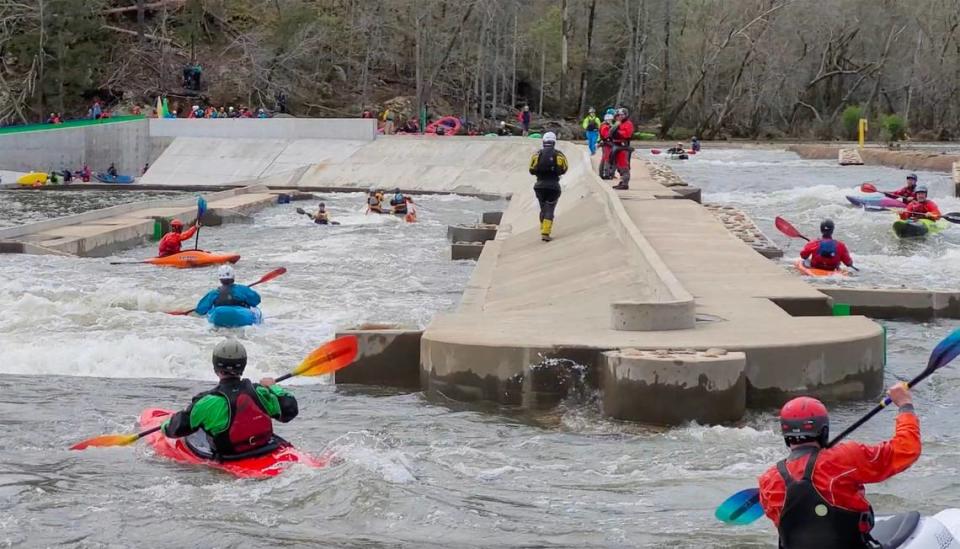
Precautions are in place
Williamson said Duke Energy coordinated with local emergency management organizations and neighboring land management agencies while planning the bypass channels.
The company placed signs at the access points that have maps of the area, warns the public of water conditions, and identifies the portage route.
Tips for navigating the long bypass whitewater rapids in Great Falls, SC
The Chester County swift water team has trained for months on how to rescue paddlers if there’s an emergency or if people get stranded in the river, said Chester County Emergency Management Director Ed Darby.
The team includes the Great Falls Fire Department, two rescue squads from Chester and Great Falls and the fire service. Other nearby rescue squads in Fort Lawn and Lando will also respond if needed.
The swift water team has specialized equipment, including boats and rafts that can carry four rescuers. Training for the rescuers is ongoing.
Cell phone service can also be spotty along the river, Darby said.
Darby said there are plans to implement mile-marker signs along the river so, in cases of emergencies, paddlers can tell rescuers their location.
“So we really, in the paddling community and those of us that have been actively involved, are still stuck on learning the river,” Colburn said.
“We’ll know more after a season or even a couple of months of releases and people start learning the river flow. For me, I’m really curious to see how people use and enjoy those base flows. They probably will be a lot more friendly to people that are just learning how to paddle.”

